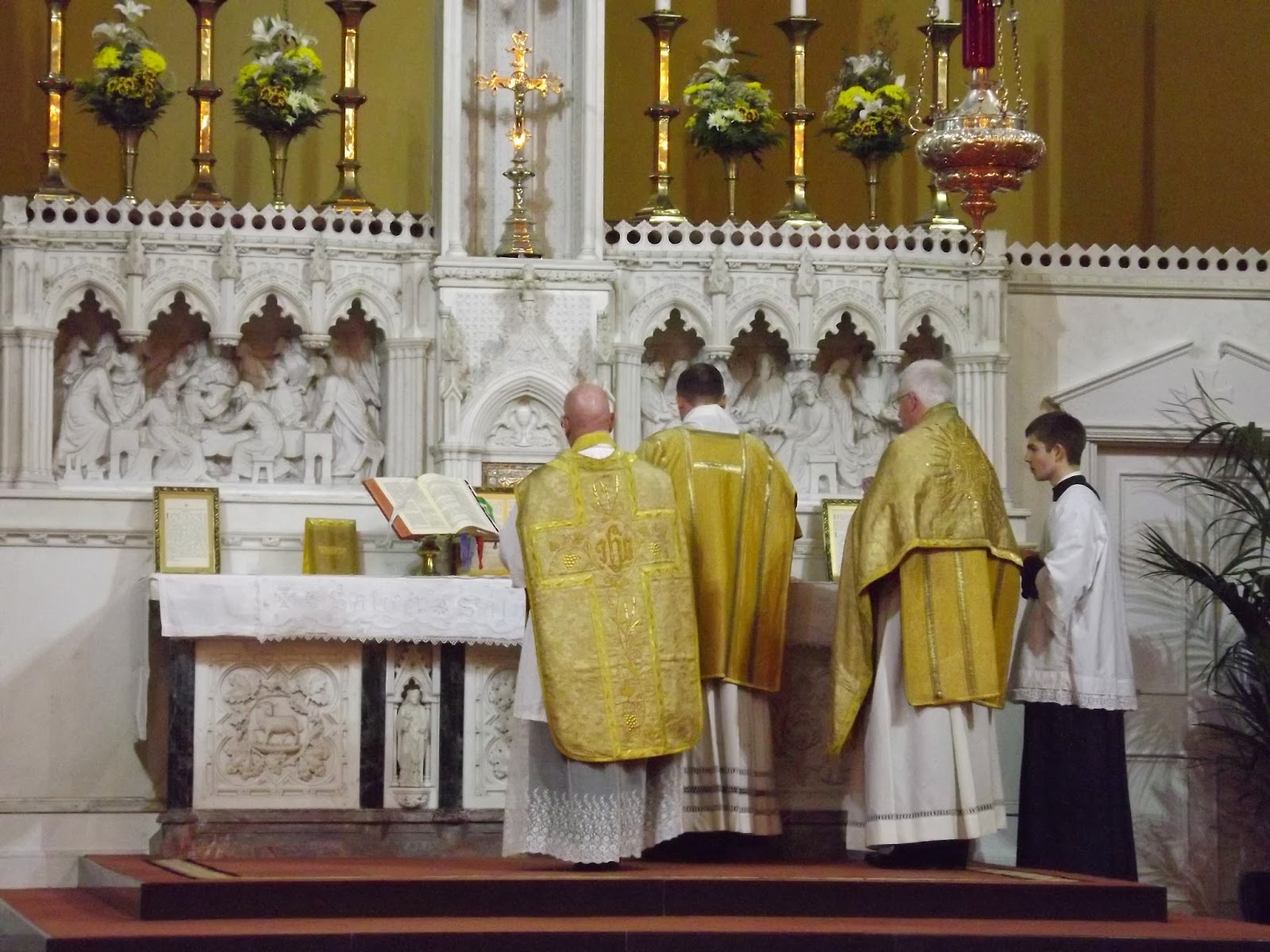With the kind permission of the Parish Priest and the generous cooperation of the Parish of New Ross and the Society of Saint Oliver Plunkett of the Diocese of Ossory, members and friends of St. Conleth's Catholic Heritage Association made a pilgrimage to New Ross, Co. Wexford, on Saturday, 25th January, 2014, the feast of the conversion of Saint Paul, with a High Mass celebrated in the Gregorian Rite in the Parish Church of Ss. Mary and Michael, at 2 p.m.
Medieval New Ross could boast five Churches, St. Mary's, St. Michael's, St. Saviour's, the Franciscan and Augustinians. The present Parish Church built upon the former market place replaced an earlier building, now St. Michael's Theatre, in 1902. The Architect, Walter Glynn Doolin (1850-1902), a student of J.J. O'Callaghan, was responsible for Churches in a range of styles in Southern Ireland: Sacred Heart, Killusty, Co. Tipperary (1882), St. Brigid, Pallasgreen, Co. Limerick (1882), Sacred Heart, Dunhill, Co. Waterford (1884), St. James, Kilorglin, Co. Kerry (1888), St. Carthage, Lismore, Co. Waterford (1892), St. Brigid, Clonakenny, Co. Tipperary (1899), St. Carthage, Castlemain, Co. Kerry (1900), Holy Cross, Ardoyne, Belfast (1900), St. Brigid, Dunaskea, Co. Tipperary (1901), Ss. Mary and Michael, New Ross, Co. Wexford (1902), St. Augustine, Dungarvan, Co. Waterford (1902), Sacred Heart, Roscommon, Co. Roscommon (1903), St. Mary's, Nenagh, Co. Tipperary (1910). The Church in limestone with granite facings still retains its original Altars by Pearse and Sharpe of Dublin and stained glass by Meyer of Munich.
The site of New Ross traces its origins to the monastic foundation of St. Abban of Doonane. The town was founded under Isabella, daughter of Strongbow and granddaughter of Diarmuid McMorrough, and her husband William Marshall. In that sense, it is doubly a twin town of Kildare, whose medieval foundations are largely due to William Marshall. The town's Royal Charter dates from 1207.
As the last fording point of the River Barrow, it's strategic value has been a constant of its history. The discharge of shot by the armies of Cromwell against one of the ancient gates of the town, Aldgate, known thereafter as Three Bullet Gate, is the origin of the 'Bearna Bhaoil' or 'Gap of Danger' mentioned in Amhráin na bhFiann, the Irish National Anthem. In the 1798 Rebellion, the Rebels led by Kelly of Killane siezed Aldgate and the town, although with immense losses. The Ballad of 'Kelly, the boy from Killane' recalls the event:
Enniscorthy's in flames and old Wexford is won
And tomorrow the Barrow we will cross
On a hill o'er the town we have planted a gun
That will batter the gateway to Ross
All the Forth men and Bargy men will march o'er the heath
With brave Harvey to lead in the van
But the foremost of all in that grim gap of death
Will be Kelly the boy from Killane
In the following centuries New Ross became a major emigration port, commemorated in the visit of President John F. Kennedy to the point of departure of his ancestors in 1963.
New Ross is the birthplace of Fr. James Cullen, S.J., founder of 'The Messenger of the Sacred Heart, the Pioneer Total Abstinence Association of the Sacred Heart, and of 'Madonna' Official Organ of the Sodalities of Our Lady in Ireland.
Book Review: Catherine of the Erie by Claudio Salvucci
-
This month I read an excellent new historical fiction work from the good
folks at Arx Publishing entitled *Catherine of the Erie, *about the life of
Cat...
5 hours ago








.jpg)











































































No comments:
Post a Comment